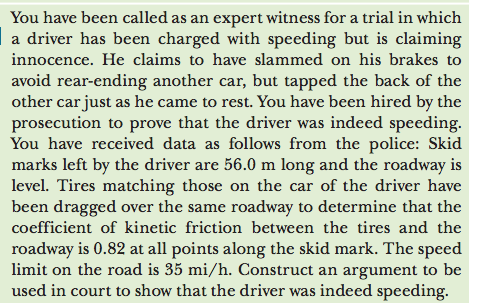You have been called as an expert witness for a trial in which a driver has been charged with speeding but is claiming innocence. He claims to have slammed on his brakes to avoid rear-ending another car, but tapped the back of the other car just as he came to rest. You have been hired by the prosecution to prove that the driver was indeed speeding. You have received data as follows from the police: Skid marks left by the driver are 56.0 m long and the roadway is level. Tires matching those on the car of the driver have been dragged over the same roadway to determine that the coefficient of kinetic friction between the tires and the roadway is 0.82 at all points along the skid mark. The speed limit on the road is 35 mi/h. Construct an argument to be used in court to show that the driver was indeed speeding.
You have been called as an expert witness for a trial in which a driver has been charged with speeding but is claiming innocence. He claims to have slammed on his brakes to avoid rear-ending another car, but tapped the back of the other car just as he came to rest. You have been hired by the prosecution to prove that the driver was indeed speeding. You have received data as follows from the police: Skid marks left by the driver are 56.0 m long and the roadway is level. Tires matching those on the car of the driver have been dragged over the same roadway to determine that the coefficient of kinetic friction between the tires and the roadway is 0.82 at all points along the skid mark. The speed limit on the road is 35 mi/h. Construct an argument to be used in court to show that the driver was indeed speeding.
University Physics Volume 1
18th Edition
ISBN:9781938168277
Author:William Moebs, Samuel J. Ling, Jeff Sanny
Publisher:William Moebs, Samuel J. Ling, Jeff Sanny
Chapter9: Linear Momentum And Collisions
Section: Chapter Questions
Problem 9.1CYU: Check Your Understanding The U.S. Air Force uses “10gs” (an acceleration equal to 109.8m/s2 ) as the...
Related questions
Question

Transcribed Image Text:You have been called as an expert witness for a trial in which
a driver has been charged with speeding but is claiming
innocence. He claims to have slammed on his brakes to
avoid rear-ending another car, but tapped the back of the
other car just as he came to rest. You have been hired by the
prosecution to prove that the driver was indeed speeding.
You have received data as follows from the police: Skid
marks left by the driver are 56.0 m long and the roadway is
level. Tires matching those on the car of the driver have
been dragged over the same roadway to determine that the
coefficient of kinetic friction between the tires and the
roadway is 0.82 at all points along the skid mark. The speed
limit on the road is 35 mi/h. Construct an argument to be
used in court to show that the driver was indeed speeding.
Expert Solution
This question has been solved!
Explore an expertly crafted, step-by-step solution for a thorough understanding of key concepts.
This is a popular solution!
Trending now
This is a popular solution!
Step by step
Solved in 5 steps

Knowledge Booster
Learn more about
Need a deep-dive on the concept behind this application? Look no further. Learn more about this topic, physics and related others by exploring similar questions and additional content below.Recommended textbooks for you

University Physics Volume 1
Physics
ISBN:
9781938168277
Author:
William Moebs, Samuel J. Ling, Jeff Sanny
Publisher:
OpenStax - Rice University

Classical Dynamics of Particles and Systems
Physics
ISBN:
9780534408961
Author:
Stephen T. Thornton, Jerry B. Marion
Publisher:
Cengage Learning


University Physics Volume 1
Physics
ISBN:
9781938168277
Author:
William Moebs, Samuel J. Ling, Jeff Sanny
Publisher:
OpenStax - Rice University

Classical Dynamics of Particles and Systems
Physics
ISBN:
9780534408961
Author:
Stephen T. Thornton, Jerry B. Marion
Publisher:
Cengage Learning
